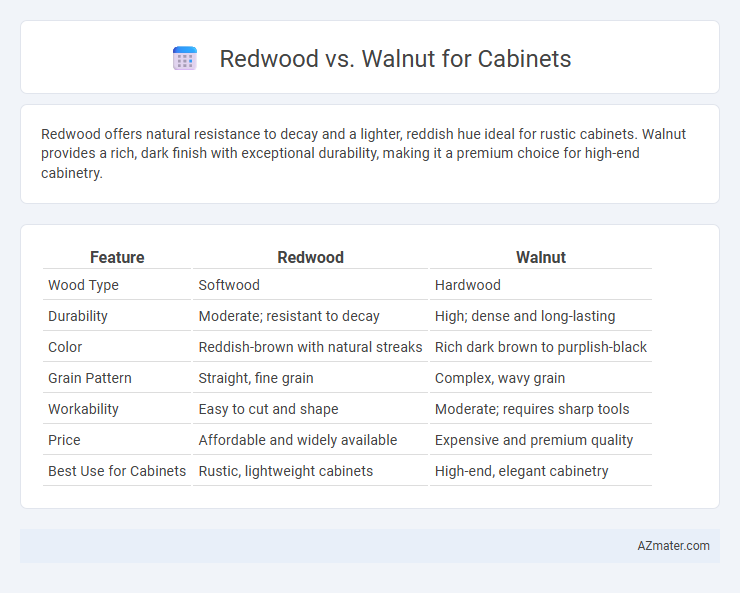Redwood offers natural resistance to decay and a lighter, reddish hue ideal for rustic cabinets. Walnut provides a rich, dark finish with exceptional durability, making it a premium choice for high-end cabinetry.
Table of Comparison
| Feature | Redwood | Walnut |
|---|---|---|
| Wood Type | Softwood | Hardwood |
| Durability | Moderate; resistant to decay | High; dense and long-lasting |
| Color | Reddish-brown with natural streaks | Rich dark brown to purplish-black |
| Grain Pattern | Straight, fine grain | Complex, wavy grain |
| Workability | Easy to cut and shape | Moderate; requires sharp tools |
| Price | Affordable and widely available | Expensive and premium quality |
| Best Use for Cabinets | Rustic, lightweight cabinets | High-end, elegant cabinetry |
Introduction to Redwood and Walnut Cabinets
Redwood cabinets feature rich reddish tones and natural resistance to decay, making them ideal for durable and visually striking cabinetry in kitchens and bathrooms. Walnut cabinets are prized for their deep, dark brown color and fine grain patterns, offering a luxurious and elegant finish that enhances both traditional and modern interiors. Both woods provide robust strength and unique aesthetic appeal, with Redwood emphasizing warmth and natural durability, while Walnut highlights sophistication and rich texture.
Physical Characteristics: Redwood vs Walnut
Redwood cabinets feature a lighter color palette with reddish-brown hues and a straight grain pattern, offering a soft and smooth texture that resists warping. Walnut, known for its rich, dark brown color with occasional purple or gray undertones, exhibits a fine and uniform grain that provides a luxurious and dense feel. Both woods are durable, but walnut tends to be harder and more resistant to dents and scratches compared to the softer and more porous redwood.
Durability and Strength Comparison
Redwood offers moderate durability with natural resistance to decay and insects, making it suitable for indoor cabinetry but less robust than walnut in heavy-use areas. Walnut exhibits superior strength and hardness, providing excellent wear resistance and longevity for cabinets in high-traffic environments. Choosing walnut ensures greater structural integrity and durability, whereas redwood prioritizes aesthetic warmth at a lighter strength level.
Aesthetic Appeal and Color Variations
Redwood cabinets showcase a rich, warm reddish-brown hue with natural grain patterns that add depth and rustic charm to interiors. Walnut offers a deeper, chocolate-brown coloration with subtle purple or gray undertones, providing a luxurious and elegant look that complements modern and traditional styles. Both woods present unique color variations, but walnut's smoother texture and darker palette tend to create a more sophisticated aesthetic compared to redwood's vibrant and textured appeal.
Workability and Finishing Qualities
Redwood offers excellent workability due to its soft texture, making it easy to cut, shape, and sand, ideal for intricate cabinet designs. Walnut, while harder and denser, provides superior finishing qualities with a smooth, rich surface that accepts stains and polishes exceptionally well, enhancing its natural grain. Both woods perform well in cabinetry, but walnut's durability and elegant finish often make it preferred for high-end projects.
Cost Differences Between Redwood and Walnut
Redwood cabinets typically cost less than walnut due to the more abundant availability and faster growth rate of redwood trees, resulting in lower raw material expenses. Walnut is a premium hardwood with a tighter grain and richer color, driving up its market price and increasing overall cabinet production costs. Investing in walnut cabinetry offers exclusive aesthetics and durability, but budget-conscious buyers often prefer redwood for a more affordable yet visually appealing alternative.
Environmental Impact and Sustainability
Redwood cabinets offer a lower environmental impact due to the tree's rapid growth rate and natural resistance to decay, reducing the need for chemical treatments and frequent replacements. Walnut, while prized for its rich color and durability, grows slower and is often sourced from old-growth forests, raising concerns about deforestation and habitat disruption. Choosing sustainably harvested Redwood certified by organizations like FSC ensures better carbon sequestration and supports responsible forest management practices.
Maintenance and Longevity
Redwood cabinets require less frequent maintenance due to their natural resistance to decay and insects, making them durable in various climates. Walnut, while visually rich and dense, demands regular sealing and polishing to maintain its finish and prevent moisture damage. Over time, redwood's stability ensures longer-lasting cabinet performance compared to walnut, which may show wear faster under heavy use.
Best Applications for Redwood vs Walnut Cabinets
Redwood cabinets excel in outdoor and rustic settings due to their natural resistance to moisture and decay, making them ideal for kitchens or bathrooms with high humidity. Walnut cabinets are best suited for indoor spaces seeking luxury and durability, offering a rich, dark finish that enhances formal living rooms or upscale kitchens. Both woods provide unique aesthetic and functional benefits, with redwood favored for durability in challenging environments and walnut prized for its elegant grain and strength in controlled indoor applications.
Choosing the Right Wood for Your Cabinet Project
Redwood offers excellent resistance to decay and insect damage, making it ideal for cabinets in humid environments, while walnut provides a rich, dark grain that enhances cabinetry aesthetics in more controlled indoor settings. For projects prioritized on durability and outdoor exposure, redwood's natural oils and stability prevent warping and cracking over time. Walnut's fine texture and workability lend themselves to intricate designs and a luxurious finish, making it a preferred choice for high-end interior cabinetry.

Infographic: Redwood vs Walnut for Cabinet
 azmater.com
azmater.com